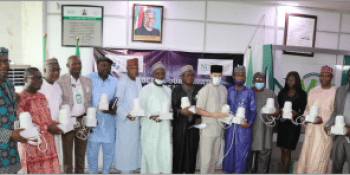Communicating climate-smart agriculture via School-on-the-Air

Transcending language, spatial, and other socio-economic barriers, radio is the most suitable channel for communicating climate-smart agriculture to farmers in Cagayan Valley in the Philippines.
As crops in the field are flattened by heavy rainfall, so are the hopes of farmers for a good harvest after months of hard work. As the soil dries due to the scorching heat of the sun, so are the mouths of people who rely heavily on agriculture for food and livelihood. Changing weather conditions and varying climatic patterns, known as 'climate change,' are wreaking havoc on the world, especially in the agricultural sector. These trying times call for collective and sustainable action to help vulnerable people and communities mitigate and adapt to a changing climate. Such action should be linked with timely, accurate, and relevant knowledge and information services.
In an era dominated by smartphones and the Internet, the Philippine government is heeding the call by harnessing an ‘old’ communication medium—radio.
Climate-smart agriculture “on air”
The Philippine Department of Agriculture (DA)—through its Regional Field Office 2 (DA-RFO2)—together with the Philippine Federation of Rural Broadcasters (PFRB) and the Philippine Agriculture Journalists, Inc. Cagayan Valley Chapter (PAJ-CV), are implementing a project, 'Kaalamang Pagsasaka sa Himpapawid', in partnership with the CGIAR Research Program on Climate Change, Agriculture and Food Security for Southeast Asia (CCAFS SEA). This project aims to:
- bring the necessary knowledge, technology, and support services to smallholder farmers and fisherfolk;
- engage rural communities in agricultural programs;
- involve the government, civil service organizations, and the private sector in agricultural programs; and
- serve as a platform where the agriculture and fisheries sectors can discuss relevant matters with one another.
The core of this project is the School-on-the-Air (SOA) Program, a distance-based learning system that utilizes radio as its main platform. Through ready-to-be-aired scripts, live interviews and plugs, technologies and practices related to climate-smart agriculture (CSA) are communicated to more than 10,000 initial farmer-learners in the major rice producing provinces of Cagayan Valley.
The SOA project is expected to help catalyze behavior change and social mobilization among key stakeholders. In particular, the project is expected to increase the awareness and deepen the understanding of farmers about climate change and CSA; enhance the application of CSA technologies and practices in Cagayan Valley, and influence policymakers to integrate CSA into their programs.
Educational and entertaining
SOA lessons are grouped into modules. The first modules will cover CSA on rice while the latter modules will discuss other major crops, livestock, and fisheries.
All lessons adopt an “edutainment” approach, i.e., they were crafted as educational enough to address knowledge and awareness gaps and entertaining enough to keep the audience’s attention. Lessons are delivered following the standard SOA format interspersed with public service announcements, music, and other entertaining treats. The lessons are aired 30 minutes daily every weekday by DWDA (a radio station owned and controlled by DA), Radio ng Bayan, and other carrier stations in the region.
Moreover, the SOA is complemented by multi-media knowledge products, information and communications technology (ICT) services and face-to-face interaction. An information database will be also built to keep the mobile numbers of stakeholders. This is to provide agro-advisories, DA-related information, and other mobile phone-based services.
The SOA project so far
A technical working group (TWG) was formed to oversee the implementation of the project. The TWG is composed of DA-RFO2, the Philippine Rice Research Institute (PhilRice), Department of Science and Technology’s Philippine Atmospheric, Geophysical, and Astronomical Services Administration, DA’s Agricultural Training Institute and Philippine Center for Postharvest Development and Mechanization, Cagayan State University, and PFRB.
The broadcasts started on 5 March 2018 in twelve radio stations in Cagayan Valley and are expected to end in August 2018. As of 16 March 2018, six episodes were already aired. Based on DA-RFO2, most of the farmer-learners are listening from Cagayan (46% of SOA enrollees) and Isabela (40% of enrollees), while the rest are from Nueva Vizcaya (10% of enrollees) and Quirino (4% of enrollees). Aside from those previously mentioned, the other project partners such as PhilRice, agencies under the Cagayan Valley Agriculture and Resources Research and Development (CVARRD) Consortium, local government units, and state universities colleges (SUCs) in Cagayan Valley assist in the broadcasts of SOA lessons.
Going forward
Climate change is indeed unforgiving and relentless in its threat to agriculture and food security. However, by linking knowledge with action through the SOA on CSA, farmers will be able to surmount these adversities and improve their livelihoods under the aegis of climate change.
On to the next episode…
Read more:
- CCAFS blog: Vietnamese farmers, media share their climate-smart agriculture experiences with Filipino broadcasters
- CCAFS blog: Rural folks to hear more climate-smart agriculture options ‘on-air’
- CCAFS blog: Tune in: Philippine rural broadcasters to promote climate-smart agriculture
Renz Louie Celeridad is the Junior Communications Specialist for the World Agroforestry Centre Philippines. He also works as Communications Consultant for CCAFS SEA.



